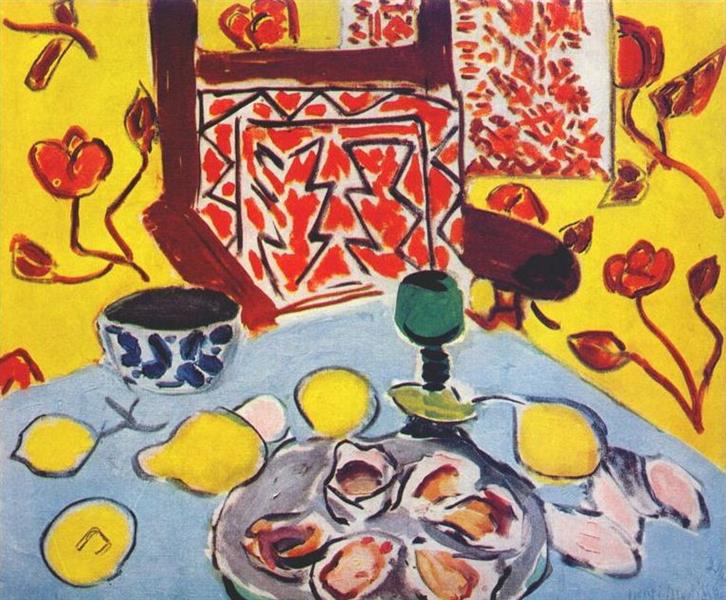Description
Henri Matisse, an eminent figure in modern art, offers us in "Oysters and Wooden Armchair" (1943) a window into his pictorial universe, where the interaction between color, form, and composition becomes a language of its own that transcends mere visual representation. This work, with its dimensions of 73x60, encapsulates Matisse's ability to transform an everyday moment into a visual poem.
At first glance, "Oysters and Wooden Armchair" invites the viewer to immerse themselves in an intimate and somewhat playful environment. The composition centers on a charming still life, where some oysters on a white plate are presented as the undisputed protagonists. These oysters, with their seemingly juicy texture and carefree arrangement, evoke both the freshness of the sea and a delightful simplicity. The wooden chair beside them adds a human connection, as if someone had just gotten up, leaving behind a trace of presence.
The use of color in this painting is particularly significant. Matisse opts for a palette dominated by warm and earthy tones, with accents in blue and white that balance the composition. The amber background envelops the scene with a welcoming luminosity, while the details in deep blue and vivid red add a touch of contrast that guides the viewer's gaze. This chromatic choice not only provides visual cohesion but also reflects the era of its creation: 1943, a time marked by the shadows of World War II, where light and color in Matisse's art offered a refuge of serenity and hope.
It is important to note that Matisse, in his artistic maturity, distanced himself from faithful representation to embrace the essential and the emotive, simplifying forms and exalting colors. In "Oysters and Wooden Armchair," this tendency is manifested in the simplification of the chair's outline and the plate, as well as in the almost schematic arrangement of the oysters, which nonetheless retain a palpable vitality. This work does not feature visible human characters, but the evocation of the oysters and the chair generates an implicit presence, an invitation to participate in the scene through the mind.
In the discourse of modern painting, Matisse was not only a pioneer but also a constant experimenter, always seeking new ways to express himself. His works from this period reflect a balance between rigorous discipline and an almost improvised freedom with color and form. Compared to his contemporaries, Matisse maintained a unique perspective: while other artists focused on the agitation and noise of the outside world, Matisse offered a reflective pause, a breath where the simplest details are enriched with new dimensions.
"Oysters and Wooden Armchair" is inscribed in a broader context of Matisse's work, in which the artist continued his exploration of the relationship between the everyday object and the construction of a personal reality through color and form. The emulation of the texture of the oysters, the sinuousness of the wood of the chair, and the flatness of the surrounding area are all manifestations of Matisse's genius, whose vision of the world always sought harmonious balance and timeless beauty.
In conclusion, "Oysters and Wooden Armchair" is not simply a painting, but a visual meditation on everyday life transformed into art. Through his mastery in the use of color and composition, Henri Matisse invites us to rediscover the magic in the familiar, to find art in the simplest moments, and ultimately, to see the world through the immortal eyes of a true master.

